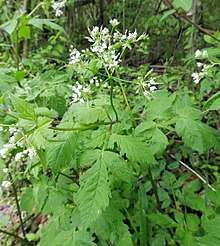Osmorhiza longistylis
Osmorhiza longistylis, commonly called long-styled sweet-cicely[1] or longstyle sweetroot,[2] is an herbaceous plant in the family Apiaceae. It is native to North America, where it is found from the Rocky Mountains east to the Atlantic Coast, in Canada and the United States.[3] Its natural habitat is in forests with fertile soil, often in areas of loam and dappled sunlight.[4][5]. It can be found in areas of high or average quality natural communities,[5] and does not tolerate intense disturbance.
| Osmorhiza longistylis | |
|---|---|
 | |
| Scientific classification | |
| Kingdom: | Plantae |
| Clade: | Tracheophytes |
| Clade: | Angiosperms |
| Clade: | Eudicots |
| Clade: | Asterids |
| Order: | Apiales |
| Family: | Apiaceae |
| Genus: | Osmorhiza |
| Species: | O. longistylis |
| Binomial name | |
| Osmorhiza longistylis (Torr.) DC. | |
It is an herbaceous perennial that grows to two and a half feet tall. It produces umbels of small white flowers in late spring and early summer. The crushed plant has a distinct scent of anise.[5]
Uses
The roots have occasionally been used as a culinary substitute for anise.[6] This species was also used historically by Native Americans as a medicinal herb.[7]
References
- Osmorhiza longistylis New England Wildflower Society
- "Osmorhiza longistylis". Natural Resources Conservation Service PLANTS Database. USDA. Retrieved 14 August 2018.
- "Osmorhiza longistylis". County-level distribution map from the North American Plant Atlas (NAPA). Biota of North America Program (BONAP). 2014. Retrieved 14 August 2018.
- Alan Weakley (2015). "Flora of the Southern and Mid-Atlantic States".
- Aniseroot Osmorhiza longistylis IllinoisWildflowers
- Yatskievych, George (2006). Flora of Missouri, Volume 2. Missouri Botanical Garden Press. p. 94.
- University of Michigan - Dearborn (OSLO): Native American Ethnobotany — Osmorhiza longistylis